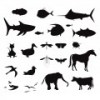As fun as it was to think about developing wings to fly like a bird, physics always wins. In case you haven't yet figured it out, the prior video was of course a fake, albeit a really entertaining fake.
That being said, here is the first ornithopter able to sustain flight. The aircraft was created by a student in the Engineering PhD program at The University of Toronto, Todd Reichert in 2010. It is human-powered and the wings are designed to mechanically flap like those of a bird:
Source
University of Toronto News
- Log in to post comments
More like this
Most birds fly. To aid flight, avian bones are hollow, reducing their mass. In addition, bird wings and feathers are optimally designed for flight.
So why can't large birds or mammals fly? One of the problems is that they are too heavy to lift off the ground, necessitating unrealistically large…
Molecular Partnership Controls Daily Rhythms, Body Metabolism:
A research team led by Mitchell Lazar, MD, PhD, Director of the Institute for Diabetes, Obesity, and Metabolism at the University of Pennsylvania School of Medicine, has discovered a key molecular partnership that coordinates body…
One of the coolest dinosaurs you learn about as a kid are Pterodactyls (really Pterosaurs, but who's checking). As giant flying lizards, these guys are thought to have dominated the skies long before birds existed (from the late Triassic to the end of the Cretaceous, 220-65 million years ago). The…
Okay, so I've been coblogging with ScienceWoman for a little over a week so far. Which means I've been blogging as me, with no pseudonym to hide behind for the same time. What do I think about it so far?
It's terrifying. I haven't told many colleagues about this blog yet, and haven't had the…


The size and shape are reminiscent of the MIT Daedalus plane. (Much much larger than the birdman wing.) The Daedalus used a human powered (leg power - bicycle transmission) propeller for thrust. I don't see a mechanism for forward thrust in this design but it must be provided by the wings somehow?
Nice i like it and what to fly :)
The takeoff thrust was provided by the chase vehicle doing the filming: you can see the paired cables in the bottom center of the frame from 1:13 to 1:41, when they're released.
From the angle of filming, it wasn't clear whether the flapping induced had much thrust, or if it was only providing lift while the vehicle glided forward.
The takeoff thrust was provided by the chase vehicle doing the filming: you can see the paired cables in the bottom center of the frame from 1:13 to 1:41, when they're released.